 Fairview Dome, Regular Route (5.9), Tuolumne Meadows, California
Introduction The Regular Route on Fairview Dome is a 12 pitch climb up the obvious steep northwest face of the dome. This climb is listed in the Fifty Classic Climbs of North America and described as such as one of the "routes which ambitious climbers dream of doing." The first pitch contains the crux 5.9 moves-some friction moves on polished granite-and the higher one goes, the more relaxed the climbing becomes. This climb would be the "test piece" for Bill and I on our two-week climbing trip to the Sierras and Tuolumne. We were very excited for the climb albeit it with a bit of reservation and nervous anticipation.
Monday, September 12th 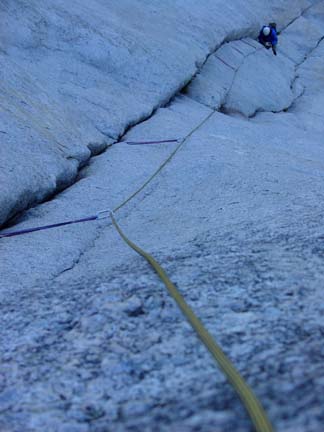 Bill following pitch 1. The crux of the route is just above him where the two cracks meet and the rock bulges out. Back on the rock, he paid closer attention to the rock and was able to carry on without issue. However, at the crux moves, he left foot again slipped off unexpectedly causing him to come off the rock again. But Bill quickly regained his composure and climbed smoothly through the rest of the pitch. When he reached the belay ledge we re-racked and he showed a very impressive bit of climbing confidence by taking off on lead without complaint. I was very impressed by this as I'm sure I would have been asking him to lead the next pitch, rated 5.8, if the situation had been reversed. He started up complimenting the wonderful hand and finger crack as he climbed. It sounded wonderful and certainly looked to be a beautiful crack. 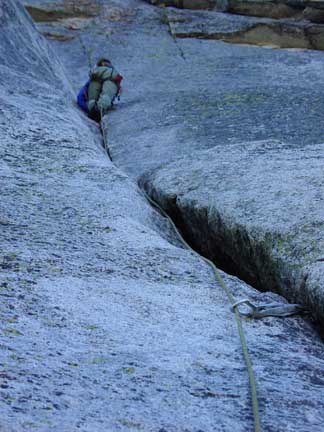 Bill leading the second pitch. Awesome crack climbing. As he ascended I heard voices and noticed another team of two below us racking up for the first pitch. We exchanged pleasantries and I learned they were from Canada. They asked if this tree ledge I was on was big enough for another and I told them it certainly was. I now felt a bit pressured as I didn't want to slowing any other parties down on the route but if that would end up being the case, so be it. This would not turn out to be the case however as we climbed much quicker than they did. Looking up the second pitch that Bill was now leading, it appeared to be overhanging near the end of the pitch and I was very glad Bill was leading now. As he neared the section that appeared to be overhanging, he moved left into a shallow dihedral just below the belay. Since I had gone the full 200 feet during the first pitch, Bill was able to link pitches 2 and 3 that are listed on the SuperTopo and he reached the small edges in the dihedral that were said to be the best belay for the pitches and setup his anchor. I followed up the crack which was fantastic. At times I could get a super solid hand jam but at other times the crack was offset enough to use it as a positive flake. A very impressive lead for Bill indeed. But by the time I reached Bill, my hands were quite chilled due to the time spent on the belay ledge below and sticking my hands into the cold crack of pitch two. As we re-racked, I rubbed and warmed by hands before setting off up our pitch 3 which is listed as pitch 4 on the SuperTopo for the route. So I'll call this pitch 4 to stay on track with the "standard" way to climb the route. This pitch took me up great 5.6 to 5.8 cracks past two pitons and a large white flake that was somehow attached to the face. It appeared one could do some chimney moves to the left of this flake or step out to exposed knobs on the face to the right. I opted for the exposed knobs to the right which turned out to be very fun and straight forward. Once on top of the flake I went up more 5.7 flakes and knobs to the excellent and huge belay ledge in the sun on the Crescent Ledge. I placed a red camalot in a crack and sat behind a large flake for the belay. It was now only 1:00pm. I yelled to Bill that I was off belay and in the sun which surely motivated him to climb swiftly up the pitch. He went left at the white flake and said it was also very good climbing before joining me at the sunny belay ledge. At this point we noticed another team of two at the base of the route just getting started. The Canadians were still working pitches 2 and 3 so we had a lot of breathing room. The climbing from here on out promised to be more relaxed and just plain fun. Our spirits were high having completed the crux pitches already. It was a beautiful day and warming up nicely. The climbing to this point had been sweet and we were excited for more. Bill started up the nice 5.4 ramp of pitch 5 that soon turned into great 5.6 flake and knob climbing to a short 5.6 crack before the belay. 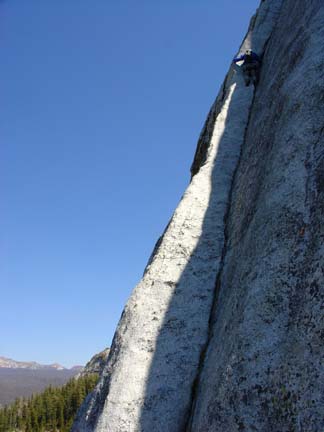 Leading up the generous ramp from the "Crescent Ledges" belay. I followed Bill up the pitch appreciating the knobs and flakes that were at our disposal. Leading pitch 6 was a blast as it started out with easy ramp climbing leading into a small roof that was protected by a piton placement. This 5.7 roof move really got my attention but once I committed to the hands of the positive flake above the roof, it went easily. I was elated to have pulled my first alpine roof! We decided I would link pitches 6 and 7 as they were quite short. Easier climbing lead to another nice belay ledge with a small tree. I brought Bill up to the ledge and we sat for a spell watching the two climbing teams below us work through pitches 4 and 2 respectively. 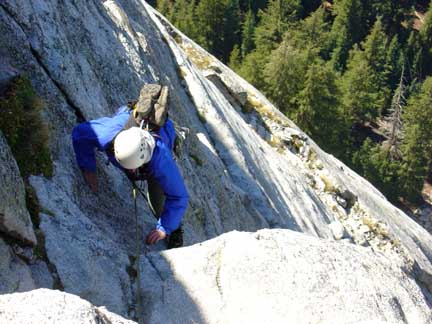 Following the 5.7 roof pitch. From here Bill lead an upward traversing pitch 8 up terrain that gradually got easier to a large belay ledge next to a big tree about 160 feet out. After I followed his lead and joined him at the belay, we decided to simul-climb the rest of the route as it looked to be no more than the occasional 5.6 move with most of the climbing being considerably easier. It was 3:20pm when we started the simul-climbing and after 20 minutes of my leading us through the simul-climbing, we made some final 5.4 knob moves onto the summit at 3:45pm. 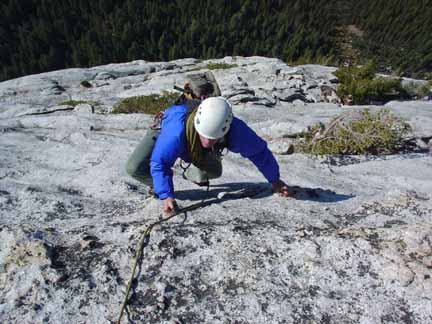 Crimping on knobs, Bill pulls the final moves to the summit of the dome. The view of the meadows and surrounding peaks was awesome. Mount Conness loomed to the north while we could see Cathedral Peak and the Eichorn Pinnacle to the south. Tenaya Lake gleamed in the valley to the southwest. 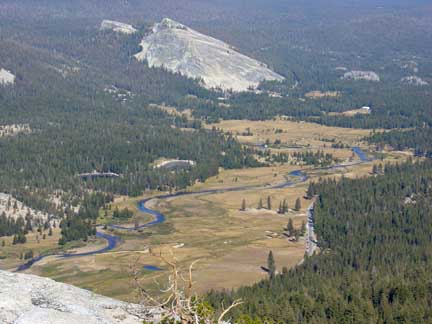 Looking east we could see the meadows from which Tuolumne gets its name as well as Lambert Dome. We lunched on the summit and relived the climbing we had just completed. The route truly was awesome and by far the best route of our trip. We climbed the route in 4:45 which was far faster than our anticipated 6 hour ascent time. The wind was calm and the weather beautiful. We donned our approach shoes for the slab descent and made it down and back to the base of the climb to watch the other two parties working up pitches 7 and 4 respectively. Seeing them on the route really put the scale into perspective. We hiked the 20 minutes back to the car and returned to camp to drink a beer to our success! Written by Jason Halladay on 16 November 2005.
|